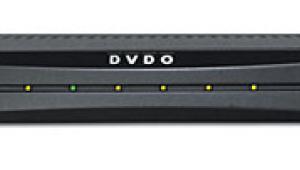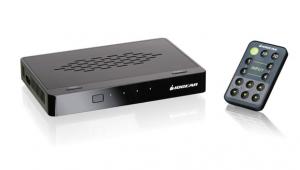DVDO Edge Video Processor

As displays get larger, flaws in the source signal and video processing become easier to see, so good scaling performance is essential for rendering high-quality images. In the past, you needed to spend upwards of $4000 on an outboard processor to get the ultimate video performance, but not any more thanks to Anchor Bay's new DVDO Edge.
Features
In the Anchor Bay lineup of video processors, the Edge falls in the budget category at $800, but it shares some of the same VRS (Video Reference Series) features with the flagship iScan VP50 Pro. It does not offer the advanced video input and output controls nor the automation capabilities of the VP50 Pro, but it does convert standard-definition and high-definition signals to 1080p. Other features include 10-bit Precision Deinterlacing for all 480i and 1080i sources and PReP (Progressive ReProcessing), which improves poor deinterlacing from source devices such as DVD players, set-top boxes, etc.
Additional VRS technologies include Mosquito Noise Reduction (diminishes visible noise common in overly compressed SD and HD content), Fine Detail Enhancement (sharpens detail in low-resolution images), and Edge Enhancement (sharpens images without ringing). For film-based content, Anchor Bay's Progressive Cadence Detection and Right Rate features lock all sources to 24 frames per second and send them at 1080p/24 to displays that can support it.
Video processors tend to delay the video image because the processing takes some amount of time, causing the audio and video to get out of sync. The Edge compensates for this with its Precision AV Lipsync, which automatically delays the audio to match the video-processing delay, assuring that the picture and sound are perfectly matched. If the delay is present in the source—a common occurrence for broadcast TV—there is a manual adjustment of up to 200 milliseconds, depending on resolution.
The Edge serves as an audio/video hub that can handle up to 10 sources, including six HDMI 1.3a inputs (one hidden behind the front panel), two component inputs, one S-video input, and one composite input. For audio not carried by HDMI, there are four digital inputs and one analog input assignable to any of the video inputs.
This processor offers a unique feature not found even on the top-of-the-line VP50 Pro—two HDMI 1.3a outputs, one for the display and one that carries audio for use with HDMI receivers and processors. For older receivers, an optical output is also provided for the audio signal.
Each input provides picture controls for Brightness, Contrast, Color, Hue, Mosquito Noise Reduction, Fine Detail, and Edge Enhancement. This is great for users who need different settings for each component and want to run only one HDMI cable to their display.
Additional features include a Game Mode that eliminates the video-processing delay for an uncompromised gaming experience. There's also a flexible aspect-ratio control for easy removal of the black bars in letterboxed and pillar-boxed images as well as correction for overscan and underscan.
- Log in or register to post comments



























































